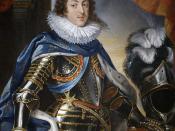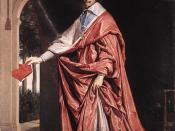During the Renaissance, humanists, having recovered numerous ancient texts, suggested 'that the grandeur of a king although established by war, was maintained by peace. The fruits of peace, they claimed, were commercial prosperity and the progress in the arts, which in turn immortalised the prince's glory.' Ritual, art and architecture may all be seen as the instruments of self-assertion, as the continuation of war and diplomacy by other means. For the purpose of this essay high culture represents painting, sculpture, ballet, opera, writing, poetry and architecture. Progress in these, were deemed to demonstrate the grandeur and power of the king in the eyes of his subjects, of foreigners and of posterity. The concept of using the arts as a tool of the state was not new to the period concerned; Cosimo de'Medici, for example, who ruled Florence from 1537 to 1574, 'was made all the more aware of the political uses of the arts in creating a good public image' due to his lack of legitimacy as ruler.
During the years of Louis XIV's 'personal rule', the use of high culture as the tool of the state is probably clearest, however, there are many examples of the arts being used for political aims during the ministries of both Richelieu and Mazarin.
During the ministries of Richelieu and Mazarin, France finally established her position as a great power in Europe. Internally during this period the last forces of discord, social and religious, were crushed and in foreign policy these years mark her victory in the struggle with Spain and the Empire. In terms of high culture, Louis XIII remained a discreet monarch, seemingly disinclined to glorify his person or his power. Antoine Schnapper notes that, 'he [Louis] even gave up the venerable tradition of the ceremonial Royal Entries, which did not...



Great Paper
Very well written piece. Very well formatted and informative. Nothing else needs to be said...
2 out of 2 people found this comment useful.